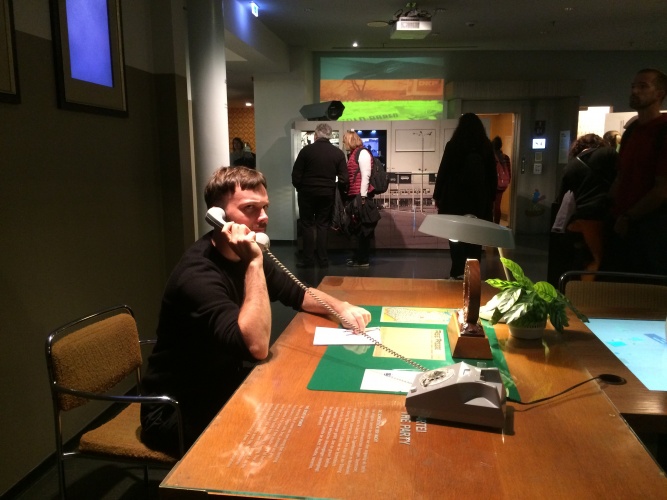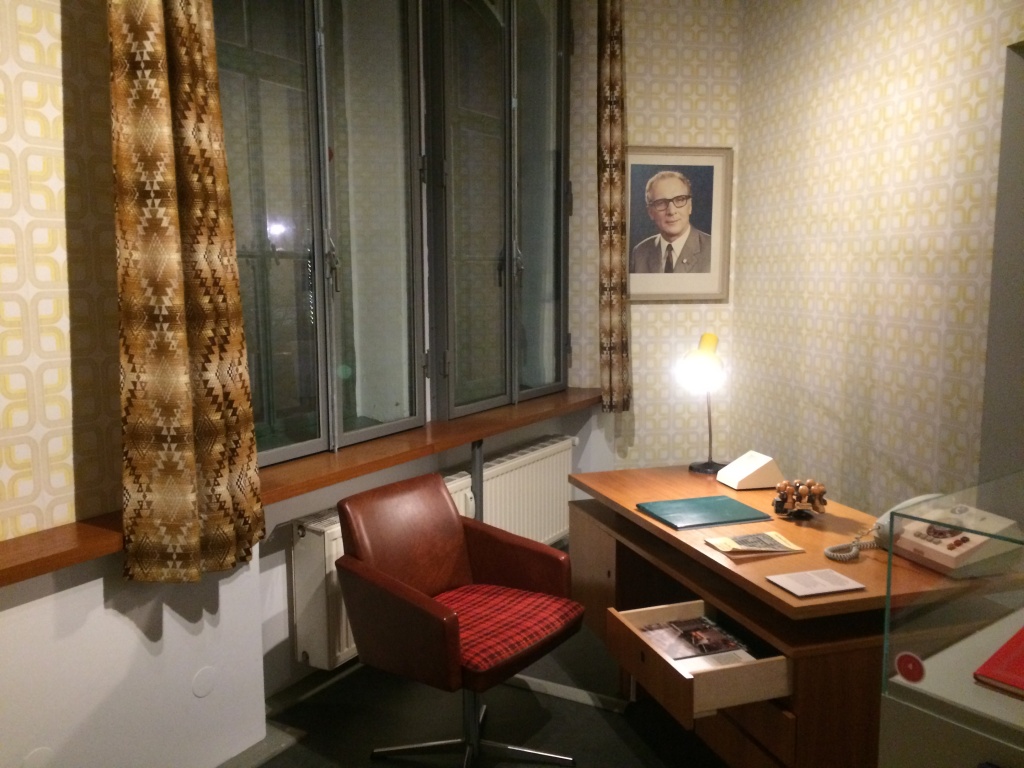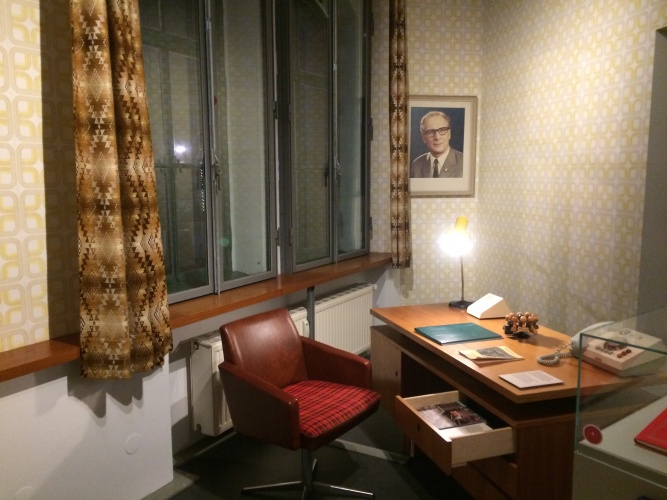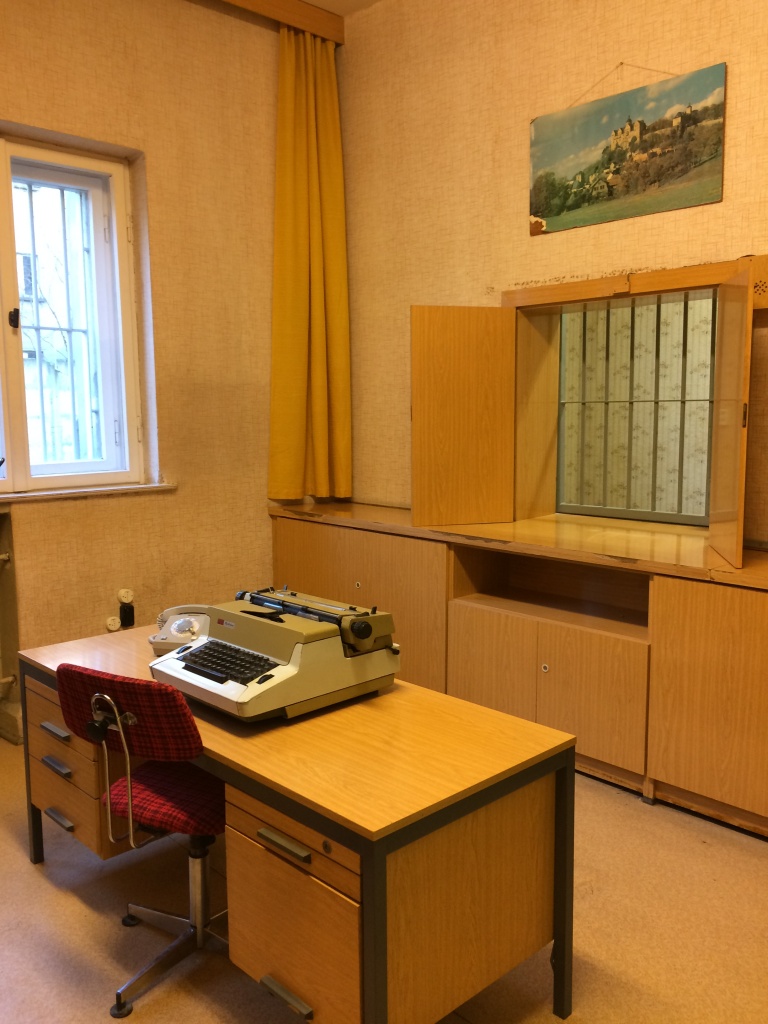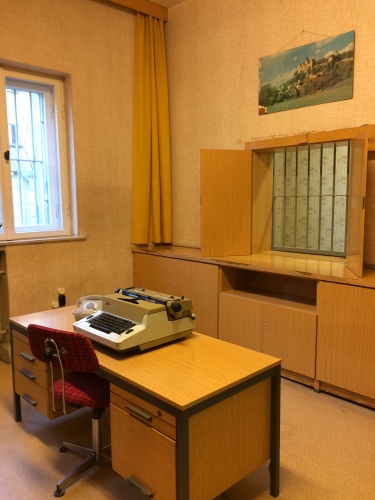The Museumslabor (Museum Laboratory) in the Institute for European Ethnology at Humboldt University (IfEE) is an open forum for researchers and practicioners from Berlin to think and discuss critically about museum and heritage related themes. It is organized by its members who jointly decide on formats and themes. The thematic focus during the 2017/2018 winter term took up the theme of IfEE’s colloquium – Constructing knowledge about and through the Other – Reflections to Demarcations of Difference between West and East Germany. The colloquium’s organizers (Urmila Goel, Blanka Koffer, Sebastian Pampuch, and Leonore Scholze-Irrlitz) had invited various researchers to reflect on the topic, including contributions on the discoursive construction of Eastern/Western Germany and East/West Germaness in public media, and processes of memorizing and musealising the German Democratic Republic (GDR).
Taking up the theme during its biweekly meetings was somehow considered obvious to Museumslabor’s members. The history of the GDR is omnipresent in Germany’s capital Berlin, a city that had been divided by a concrete wall to separate the two Germanys from each other between 1961 and 1989. The city itself could be considered a large heritage site, and traces of the past are still present in people’s practices, their language, and gestures. Despite Germany being formally reunified since 1990, being raised as “Ossi” or “Wessi” (socialized in the former East or West) does still make a difference, which becomes obvious in conversations between Germans about “the past”. While most people raised in the former West (the Federal Republic of Germany, FRG) have only little, and mostly vague ideas and imaginations about life in the GDR (mainly connected to the GDR’s politics, the country’s past is memorized quite vividly by people born and raised in the former East. These differences are occassionally adressed in informal conversations between colleagues, recurring themes being the dominance of Wessis in Germany’s political and academic elites, the lack of knowledge and debate about the many facets of life in the GDR or other socialist states, sometimes sparked by comments on Western ignorance, or at least lack of interest. Like other themes currently hotly debated, e.g. Germany’s colonial past and its consequences and continuities, this theme also touches upon our private and professional lives. Maybe this was the reason, why, after intensive discussions about which of the myriad of sites to visit, museumlabor’s members agreed to visit two exhibitions which dealt with quotidian life in the GDR. The museums we chose were the privately funded GDR-Museum, widely advertised (already at Berlin’s airports), and the Museum in der Kulturbrauerei which belongs to Stiftung Haus der Geschichte der Bundesrepublik Deutschland (House of the History of the Federal Republic of Germany Foundation). Apart from these, the group decided to visit two memorial sites: the Memorial Berlin-Hohenschönhausen which has been established on the site of a former prison of the GDR’s state security police, and the Memorial of the Berlin Wall at Bernauer Straße.
In the following, three members of the museumslabor reflect on the visits to these institutions, relating to their own personal interests and experiences.
Reflection by Tabea Malter (Institut für Kulturwissenschaften, Humboldt-Universität zu Berlin)
Die Beschäftigung des Museumslabors mit der Darstellung der DDR-Vergangenheit an verschiedenen Ausstellungsorten in Berlin bot mir eine Gelegenheit, mich mit einem Thema auseinanderzusetzen, mit dem ich bisher vergleichsweise wenig in Berührung gekommen bin. Da ich erst nach der Wiedervereinigung geboren wurde und als Saarländerin im „tiefsten“ Westen aufgewachsen bin, habe ich keine eigenen Erinnerungen an oder Erfahrungen mit der DDR. Zum Ende des Semesters stellt sich mir nun die Frage, ob ich durch die besuchten Ausstellungen und historischen Orte einer Art „DDR-Erfahrung“ näher gekommen bin. Natürlich ist ein Ausstellungsbesuch keine tatsächliche Reise in die Vergangenheit, auch wenn immer wieder impliziert wird, dass Museen ein Erfahren oder Erleben der Vergangenheit ermöglichen (beispielsweise wenn das DDR Museum auf seiner Website verspricht: „Im DDR Museum erfahren Sie alles über das Leben in der Deutschen Demokratischen Republik! Sie sind eingeladen, Ihr Wissen unterhaltsam zu erweitern und Geschichte hautnah zu erleben.“ [DDR Museum. „Geschichte zum Anfassen“. Aufgerufen am 28.02.2018. https://www.ddr-museum.de/de/sammlung/ausstellung]). Die Bestrebung eines Museums, nicht nur schulmeisterlich Wissen zu vermitteln, sondern authentische Erfahrungen zu ermöglichen, ist lobenswert, aber kann eine Ausstellung wirklich authentisch sein? Letztlich ist auch eine rekonstruierte Plattenbau-Wohnung ist eben nur ein Nachbau. Dennoch: Kommt meine Vorstellung vom Leben in der DDR der Realität nun näher?
Vor allem beschäftigt mich der Vergleich des DDR Museums mit der Ausstellung „Alltag in der DDR“ im Museum in der Kulturbrauerei, da diese beiden Häuser in ihren Ausstellungen ganz unterschiedliche Strategien der Inszenierung und Vermittlung verfolgen. Das DDR Museum setzt viele verschiedene Medien ein, es versucht, Inhalte spielerisch zu vermitteln und stellt Räume und Situationen nach.
Im Museum in der Kulturbrauerei wird dasselbe Thema dagegen nüchterner aufgearbeitet. Im Gegensatz zum DDR Museum gibt es hier kaum Hands-on-Stationen und die Ausstellungstexte sind objektiv und in wissenschaftlichem Stil formuliert. Man tendiert schnell dazu, der letzteren Ausstellung höhere wissenschaftliche Qualität zu unterstellen. Zur Inszenierung im DDR Museum kommt mir dagegen unweigerlich das Wort „Disneyfizierung“ in den Sinn. Wie zu erwarten, hat aber die Ausstellung im DDR Museum eine größere Reichweite im Sinne höherer Besucherzahlen. Nun soll ein Museum bekanntermaßen der Öffentlichkeit dienen. Es kann also nicht das Ziel eines Museums sein, nur einer kleinen, eng definierten Zielgruppe qualitativ hochwertig aufgearbeitete Inhalte zu vermitteln. Andererseits sollte der Erfolg einer Ausstellung aber nicht ausschließlich an der Quantität der Besuche gemessen werden, sondern natürlich auch an der Qualität. Es stellt sich also die Frage, die Ausstellungsmacher immer wieder umtreibt: Wie kann eine gute Balance zwischen Unterhaltungswert und niedrigschwelligem, spielerischem Zugang einerseits und inhaltlich höchster Qualität und Komplexität andererseits gefunden werden? Gerade bei der Vermittlung eines so sensiblen Themas wie der DDR-Vergangenheit will dies gut überlegt sein.
Reflection by Chiara Garbellotto (CARMAH, Humboldt-Universität zu Berlin)
I joined the last semester Museumslabor with an idea in my mind, a theme that I wanted to use as lens to look at the museums and memorials that we were about to visit: the role that the narrative about the GDR and the German reunification played for the other European nation states, or at least for the Italian context. I was particularly interested in how that piece of history became also part of other histories, filtered and reassembled into a cultural symbol. One of the most striking examples was for me the images and videos of the people tearing down the Wall, broadcasted innumerable times first on cable TVs and now on YouTube. They are maybe one of the more consumed European visual heritages. Another example I was thinking about was the role of the material culture connected to the phenomenon of Ostalgie circulating as symbolic commodity in the routes of both tourists and the so called “expats”. I was wondering: what role do museums and memorials play in this imaginary about GDR produced by more-than-German cultures? With these considerations in mind, I was curious to learn whether any kind of connection to the broader history of Europe was present, embedded in the materiality of spaces, objects, and heritage performances.
Along the four visits that we made, one of the threads of discussion that responded to and expanded my initial interest concerned the link that the exhibitions and the guided tours had to the contemporary life of Berlin. This issue came up at the Gedankstätte Berliner Mauer, when some of us pointed at the possibility of working with local residents on the theme of memory, but also on issues such as gentrification or open participation to projects of memorialisation and urban planning. Reflecting after the end of the Museumslabor, the four visits appear to me as custodians of two distinct representational frameworks. On one side, displays of objects and texts – more or less interactive and paced – offered us two narratives that, even if differing in the way the Western gaze assumed the role of omniscient curator, to a certain extent were similar in focusing on the daily people’s life in what emerged as a homogeneous and hermetically closed society. On the other side, the guides accompanied us along two linear itineraries that focused on the situatedness of the stories narrated. The individual visit to the exhibitions, centered mainly on the act of seeing, became in the two Gedenkstätte a group performance of listening and asking. Again, striking differences emerged from the two memorials: clearly, the guide in the Staasi prison – an ex-detainee, as all the guides there – affected our experience with a deep layer of complex psychological insights coming from a self-presentation told through a re-reading of his individual past. Still, the structure of the two tours allowed, in my opinion, similar possibilities of performing history in heritage sites and not much space for opening it up to multiple interpretations, conflicting voices, and diversity of memories. Moving slightly away from my interest on how the GDR past influenced other European histories, I focused more on how the publics were invited to think about and re-work on history itself.
The overall feeling that describes my concern about the four visits is what can be perceived when looking into the past through a window – being it a glass case or a performed narration. In writing this, I cannot forget that my perspective on this specific history differs immensely to that of the other participants, not in terms of value or quality of the experience itself, but in terms of symbolic load and personal memories. Moreover, I cannot as well take these four visits as exemplifications of the diversified offer of museums, cultural institutions, and memorials working on the GDR past in Berlin. Nevertheless, the comments and interpretations of the other participants gave me the chance to acknowledge some existing problematic issues concerning how the power of representing the Other was enacted after the German unification and made into normative discourses through exhibition making and memorialisation. Listening to them and combining their reactions to mines, I could not help but questioning the representational power of the two frameworks that I presented, and ask what do they produce in keeping the history narrated in a distant past, without tracing connections to the present.
In order to expand and develop these thoughts, I do believe that a fertile direction to follow would be to reflect on why the guided tour with the ex-prisoner remains for me the best example of open conversation and problematic narration of the GDR times. Exactly because of its subjective and performative quality, that experience did not put me, as visitor, in the position of craving for multimedia interaction or information overdose. It gave me, instead, simply the possibility of being directly involved in a very troubling conversation. But isn’t this what history is, after all?
Reflection by Christine Gerbich (CARMAH, Humboldt-Universität zu Berlin)
Museums communicate stories about the past via objects. Joining the museumslabor to find out about constructions of the past in Berlin, I had mainly two questions in mind: What objects would be chosen to tell the everyday routines, and banalities of the GDR’s political system? What would be the dominant narrative about it? With these questions in mind, I went back to my photo archive.
My knowledge and feelings about the GDR’s past are more or less second hand. I only visited the GDR once, during a school excursion to East Berlin. Later, after I had moved to Berlin, my limited knowledge about everyday life in the GDR became enriched by the stories I picked up in conversations with colleagues and friends. They shared their memories about the “Jahresendzeitfiguren” they found in the basements of their parents (“figurines for the end of the year” was a term that had been invented by the secular system to replace the term “angel”), and introduced me to what a friend from Dresden called “the taste of the East” – products like famous Rotkäppchen Sekt (sparkling wine), Bautz’ner Senf (mustard), or Florena (body crème) that were produced in the GDR. Some people told me about their family’s traumatic experiences with the regime, others were still proud about the rank they had achieved in the FDJ (Freie Deutsche Jugend/ Free German Youth) – the GDR’s youth movement. They described the amendable sites of growing up in a small state where everybody was somehow part of a collective. None of them would want to go back to the old regime. But at the same time, they describe it as a home you can never return to. Would the diversity of these experience be reflected in the stories told?
Scrolling through the images in my archive I was surprised to find a recurring motif in nearly all of the institutions we had visited. To engage people with the GDR’s administrative machinery, a desk had been put on display, partly accompanied by stationary or typical technical devices. However, each of the institutions we visited encouraged different ways of engagement.
A member of the museumslabor engaging with the office situation in the GDR-Museum. November 2017.
A member of the Museumslabor engaging with the office situation in the GDR-Museum. November 2017
The GDR-Museum, “set up as a theme park rather than a museum”, as somebody commented, uses various interactives to engage the senses and people of all ages. It offers “authentic” GDR-peppermint at the cashier, and guides people literally through an “iron curtain” into the exhibition space. There they will find several immersive spaces (a kindergarden, a prison cell, an apartment), various interactive and sound installations. Rather than providing indepth information about the political system, exhibits predominantly poke fun about the GDR’s political system and those formally in power.
Here, the desk had a bottle of booth in the drawer, and, picking up the phone arranged on it, people would listen to the fake monologue of a “typical” GDR official. The way people interacted with this office situation reminded of what Bakhtin’s describes as carnevalesque – the visitors as kings, mocking those in power.
Office situation in the exhibition Everyday live in the GDR at Museum in der Kulturbrauerei. December 2017.
Office situation in the exhibition Everyday live in the GDR at Museum in der Kulturbrauerei. December 2017
A very similar installation could be found in the Museum in der Kulturbrauerei (see image 2). Here, however, the desk was used to mimic an “authentic” office. Sitting at the desk, one could listen to original voices, and read through the original formulars created by bureaucrats of the the GDR’s state-directed economy. The interaction with this more informative exhibit told the story of the precision of the administrative machinery that made it difficult to escape from a mainstreamed life. In contrast to the exhibit in the GDR-Museum, this display put me in the role of a observer, evoking a feeling of distance.
An office in the former prison of Staatssicherheit in Berlin-Hohenschönhausen. March 2018.
An office in the former prison of Staatssicherheit in Berlin-Hohenschönhausen. March 2018
The last image was taken in the memorial located in one of the GDR’s state security service prisons in Berlin-Hohenschönhausen. This time, the object was located “in situ”, in one of the prison’s offices. There were no labels attached to it, but interpretation was provided by a former prisoner, who used fragments of his own story to explain to us the psychological mechanisms at work. I left the space with feelings of consternation and trepidation, but at the same time, with some resentment as the tour had not allowed for a real dialogue.
There is no doubt that it is an important task of museums and memorial sites to educate about the repressive system of the GDR and to remind of its opponents and victims. The unique heritage landscape in Berlin makes it possible to hear, learn and experience these stories from very different angles as each heritage site seems to provide its own angle and affective atmosphere. However, what I, and others, were struggling with is the overall lack of multiplicity of perspectives, affects, and interpretations of the GDR’s past in each of the institutions. The “office” installations are told a single story, and evoked very specific feelings rather than allowing for multivocality. Providing such multivocality is difficult, and it is only fair to say that the exhibitions we saw did provide other approaches to engage with the GDR’s past. But looking at the images of these desks that had been chosen as symbols for power, I found that my main questions have still not been answered: What did people think and feel who supported the regime? What were their motivations? And what are the continuities to be found today, that shape our common encounters with “the East” and “the West”?
Chiara Garbellotto is a doctoral researcher at the Centre for Anthropological Studies on Museums and Heritage (CARMAH). Her research takes the Berlin Museum für Naturkunde as a case study to examine biodiversity as a material-semiotic object through the lens of public engagement practices.
Christine Gerbich is a doctoral researcher at CARMAH. Her work focuses on institutional change and the role of participatory approaches, using the Museum of Islamic Art as a case study.
Tabea Malter is a doctoral researcher at the Institut für Kulturwissenschaften at Humboldt University, funded by Gerda Henkel Stiftung. Her research is on memory, heritage and identity in archaeological museums.

